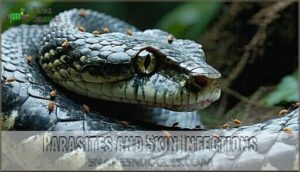This site is supported by our readers. We may earn a commission, at no cost to you, if you purchase through links.
 If you spot unusual scales, sores, or discoloration on your snake, you’re likely dealing with a skin infection that needs prompt attention.
If you spot unusual scales, sores, or discoloration on your snake, you’re likely dealing with a skin infection that needs prompt attention.
Snake skin infection treatment typically involves antibiotics for bacterial issues or antifungal medications for fungal problems, prescribed by an exotic vet.
You’ll also need to address environmental factors like humidity levels and substrate cleanliness that often trigger these conditions.
Quick action prevents minor irritation from becoming serious health complications, and the key lies in understanding what type of infection you’re facing and creating the right healing environment for recovery.
Table Of Contents
- Key Takeaways
- Identifying Snake Skin Infections
- Causes of Snake Skin Infections
- Treating Snake Skin Infections
- Managing Abscesses and Lesions
- Preventing Snake Skin Infections
- Frequently Asked Questions (FAQs)
- What does a skin infection look like on a snake?
- How to treat bacterial infection in snakes?
- What does snake skin rot look like?
- How do you treat snake blisters at home?
- How do you treat a snake infection?
- How do you treat snake fungal infection?
- How to treat snake dermatitis?
- How do you get rid of a snake abscess?
- How long does skin infection treatment take?
- Are natural remedies effective for snake skin infections?
- Conclusion
Key Takeaways
- Act quickly when you spot discoloration, sores, or unusual scales – Early treatment prevents minor skin irritation from becoming serious health complications that are harder and more expensive to treat.
- Work with a reptile vet for proper diagnosis and medication – You’ll need prescription antibiotics for bacterial infections or antifungal treatments for fungal problems, as home remedies are not effective for snake skin infections.
- Fix environmental problems that caused the infection – Poor humidity levels, dirty substrate, and inadequate enclosure cleaning often trigger skin infections, so you’ll need to address these root causes.
- Maintain proper husbandry to prevent future infections – Keep humidity between 50-60%, clean the enclosure weekly, provide appropriate substrate, and monitor your snake’s behavior daily for early warning signs.
Identifying Snake Skin Infections
You’ll need to spot skin infections quickly to keep your snake healthy and prevent serious complications.
Recognizing the early warning signs helps you start treatment before minor issues become major health problems.
Common Types of Snake Skin Infections
You’ll probably deal with a few key culprits regarding snake skin troubles.
Here are four common types to watch for:
- Bacterial Infections, like snake bacterial infection and treating snake dermatitis
- Fungal Diseases, such as snake fungal infection and scale rot
- Parasitic Infections, like mites
- Environmental Dermatitis, caused by humidity or dirty enclosures
Snakes frequently present with various scale conditions, often due to poor husbandry.
This can lead to distinct scale conditions, which are important to identify and treat promptly.
Signs and Symptoms of Skin Infections
When examining your snake for skin infections, watch for unusual scales appearance changes like discoloration, roughness, or abnormal texture.
Healthy scales mean a healthy snake – watch for changes that signal trouble ahead.
Snake skin lesions may appear as raised bumps, ulcers, or discolored patches. Shedding issues include stuck shed or incomplete molting cycles.
Behavioral changes like lethargy or hiding more frequently often accompany infections. Appetite loss commonly occurs with reptile skin disease.
Look for snake scale rot appearing as dark, soft spots on belly scales. Different lesion types indicate various snake fungal infection severities requiring prompt attention.
How to Diagnose Snake Skin Infections
Spotting snake skin infections starts with careful Visual Examination. Look for snake skin lesions, scale abnormalities, or changes in shedding.
Sudden Behavioral Changes—like hiding or skipping meals—raise red flags for snake skin infection symptoms or even snake scale rot.
Odd odors or open wounds might signal a snake skin ulcer. One early sign may include brownish scale discoloration.
Always check with a reptile vet for a Vet Consultation.
Factors That Increase The Risk of Skin Infections
After spotting snake skin infection symptoms, you’ll want to know what puts your pet at risk.
Shedding issues and low humidity levels often lead to snake skin shedding problems.
Dirty enclosures and stress factors, like excessive handling, are big culprits too.
Don’t forget, nutritional deficiencies and snake skin parasites can have a serious impact on reptile skin health and care.
Causes of Snake Skin Infections
Understanding what causes skin infections in your snake helps you prevent and treat these problems effectively.
Several factors can lead to skin issues, including bacteria, fungi, parasites, and poor environmental conditions that weaken your snake’s natural defenses, which is crucial for maintaining its health.
Bacterial Dermatitis
Bacterial dermatitis develops when harmful bacteria invade your snake’s compromised skin barrier.
Harmful bacteria break through weakened skin, creating wounds that need immediate attention.
These infections create open wounds that worsen without proper snake skin care. Antibiotic resistance makes treatment challenging, so preventative measures matter most.
Watch for infection severity signs like spreading lesions or snake skin shedding problems. Secondary infections often follow, requiring snake antibiotics or topical antibiotics.
Maintaining ideal reptile skin health prevents most bacterial issues from starting.
Fungal Infections (Snake Fungal Disease)
Snake Fungal Disease (SFD) poses serious threats to snake populations.
SFD Symptoms include crusted lesions, swelling, and facial disfigurement.
Environmental SFD spreads through contaminated surfaces, making SFD Transmission a major concern.
Antifungal treatment snakes requires specialized medications, though Antifungal Resistance complicates recovery.
Preventing snake infections through proper snake skin care and snake wound care remains essential.
Emerging Treatments show promise, but treating reptile wounds requires veterinary expertise for effective outcomes.
Diagnosis often requires laboratory confirmation of SFD.
Parasites and Skin Infections
When you deal with Mite Infestations, Tick Exposure, or Protozoan Infections, expect irritated snakes with itchy, damaged scales.
Internal Parasites can leave them run-down too.
Regular mite treatment, strict reptile hygiene, and sticking to snake quarantine protocols stop outbreaks.
Prompt snake wound care and treating reptile wounds right away are key steps for preventing snake infections before things get out of hand.
Environmental Factors That Contribute to Skin Infections
Creating the right environment is essential for preventing skin infections in your snake.
Poor humidity levels and incorrect temperature gradients stress your pet’s immune system.
Dirty substrate hygiene breeds harmful bacteria and fungi.
Inadequate enclosure size and poor ventilation quality trap moisture and contaminants.
Regular cleaning maintains proper reptile hygiene and prevents disease outbreaks.
Treating Snake Skin Infections
When your snake develops a skin infection, you need to act quickly to prevent it from getting worse.
Treating these infections usually involves using the right medications and making changes to the snake’s environment to help them heal.
Antibiotic Therapy for Bacterial Dermatitis
When treating bacterial dermatitis in your snake, the right Antibiotic Selection is key. Oral antibiotics should only be used if there’s clear evidence of infection.
Follow Dosage Guidelines closely—mistakes can lead to Resistance Concerns. Treatment Duration matters, so finish the course.
Azithromycin treats respiratory infections effectively. Support gut health with Probiotics Support.
It’s not much different from fine-tuning horse racing coverage!
- Reduced stress for your reptile companion
- Fewer setbacks in recovery
- Peace of mind, like catching live racing coverage with built-in racing tips
Antifungal Medications for Fungal Infections
When fungal infections attack your snake’s skin, you’ll need antifungal medications to fight back.
Azole antifungals and polyene antifungals work effectively against snake fungal disease. Allylamine treatments target dermatophytes specifically.
Apply topical application directly to affected areas, while systemic antifungals treat severe infections internally.
Many owners purchase snake medication online for convenience. Follow dosage guidelines carefully and monitor for resistance development during treatment.
Deworming Medications for Parasites
When parasites invade your snake’s system, selecting the right deworming medication becomes essential for recovery.
Here are five key considerations for effective parasite treatment:
- Medication Types – Fenbendazole targets roundworms, while ivermectin handles mites and nematodes
- Deworming Schedule – Most treatments require 2-3 doses spaced 14 days apart
- Dosage Calculation – Precise weight-based dosing prevents under or overdosing
- Resistance Issues – Rotating medications helps prevent parasite resistance
- Preventative Measures – Regular health monitoring reduces future infections
Follow your vet’s protocol exactly to avoid complications. Some owners use fenbendazole for treatment.
Topical Treatments for Skin Infections
Topical medications provide direct treatment for infected snake skin without stressing your pet with oral medications. Antiseptic solutions like betadine offer gentle cleaning, while antibiotic ointments target bacterial infections effectively.
Many owners source betadine for snake care online.
- Triple antibiotic ointment – Apply sparingly twice daily for broad-spectrum infection therapy
- Chlorhexidine solution – Use diluted for gentle cleaning and wound preparation before cream application
- Antifungal creams – Clotrimazole or terbinafine for fungal skin infections with proper dosage frequency
- Treatment duration – Continue topical therapy for 21 days or until complete healing occurs
Environmental Changes to Prevent Infection
Environmental modifications prevent infections more effectively than treatment alone.
Maintain proper humidity control between 50-60% and consistent temperature regulation within your snake’s ideal range.
Choose absorbent substrate that resists bacterial growth, and practice thorough enclosure sanitation weekly, ensuring excellent water quality.
These preventive measures reduce infection risk substantially while supporting natural healing processes.
Managing Abscesses and Lesions
When your snake develops abscesses or lesions, quick action prevents serious complications and promotes faster healing.
These infected areas require careful cleaning, proper drainage, and consistent monitoring to guarantee your pet recovers completely, which is crucial for preventing serious complications.
Identifying and Treating Abscesses
After treating the infection, you’ll need to address any swollen, pus-filled bumps that develop. These abscesses require immediate attention to prevent complications.
Abscess Location matters – surface bumps are easier to treat than deep internal ones.
Here’s your action plan:
- Make a small Incision Technique using sterile blade at the lowest point
- Apply gentle pressure for proper Drainage Methods to remove infected material
- Clean thoroughly with saline solution to flush remaining debris
- Select appropriate Antibiotic Choice like silver sulfadiazine ointment
- Implement daily Wound Care with fresh bandages and monitoring
Watch for signs of healing over the following days.
How to Manage Open Wounds and Lesions
Open wounds demand immediate attention and proper care.
Wound cleaning with dilute antiseptic solutions prevents bacterial growth. Follow these steps:
- Clean wounds daily with diluted chlorhexidine or povidone-iodine solutions
- Apply non-adherent dressings with silver or honey for infection control
- Change bandages daily to maintain moist healing environment
- Monitor tissue regeneration for signs of healthy granulation
Professional veterinary guidance guarantees optimal pain relief and scar management outcomes. Maintaining proper hygiene and cleanliness is also vital; hence, weekly enclosure cleaning is highly recommended.
Preventing Infection in Open Wounds
Why risk complications when prevention is straightforward? Wound cleaning with sterile saline removes debris effectively.
Apply antiseptic use protocols with diluted betadine solutions. Barrier protection through clean gauze prevents contamination.
Humidity control between 50-60% supports healing without bacterial growth. Monitoring healing daily guarantees infection treatment stays on track.
| Prevention Method | Application | Frequency |
|---|---|---|
| Sterile saline flush | Clean wounds gently | 2x daily |
| Antiseptic solution | Apply with cotton swab | Once daily |
| Barrier dressing | Cover with sterile gauze | Change daily |
| Humidity monitoring | Check enclosure levels | 2x daily |
| Visual inspection | Look for infection signs | Daily |
Promoting Healing and Recovery
After treating wounds, focus on creating the right conditions for snake skin infection treatment and recovery.
Your snake’s healing depends on consistent care:
- Wound Management: Clean dressings changed regularly prevent reinfection
- Nutritional Support: Balanced meals boost immune system strength
- Hydration Importance: Fresh water access speeds skin recovery processes
- Stress Reduction: Quiet environments promote faster healing
- Supportive Care: Monitor progress and maintain proper temperatures for ideal snake health
Preventing Snake Skin Infections
Prevention is your most powerful tool against snake skin infections.
By maintaining proper husbandry practices and staying alert to early warning signs, you’ll keep your snake healthy and avoid costly treatments.
Proper Husbandry Practices
Proper husbandry forms your foundation for preventing skin infections. You’ll need correct enclosure size, temperature gradient, and humidity levels for your snake’s species.
Choose appropriate substrate choice that stays dry and clean. Use gentle handling techniques to minimize stress. Feed quality meals regularly.
Think of it like maintaining ideal conditions—just as horse racing requires precise track conditions for racing events. Regular cleaning helps maintain proper environmental conditions and prevents infections.
Maintaining a Clean Environment
Clean enclosures prevent skin infections through consistent substrate sanitation and waste removal. Replace soiled bedding weekly and spot-clean daily.
Maintain water quality by changing bowls every few days. Proper ventilation prevents humidity buildup that breeds bacteria.
Disinfect tools and surfaces monthly. Good enclosure hygiene creates a healthy environment where your snake can thrive without infection risks.
Quarantine and Isolation Procedures
Quarantine setup becomes your first line of defense when introducing new snakes to your collection.
Proper isolation protocols prevent disease transmission and protect your existing reptiles from potential infections.
Key quarantine elements:
- Quarantine duration: Maintain isolation for at least 90 days minimum
- Isolation setup: Use separate room with dedicated equipment and regulated temperature
- Monitoring protocols: Conduct daily health checks with expert analysis of behavior changes
Monitoring Your Snake’s Health and Behavior
Daily monitoring keeps you ahead of skin infections.
Watch for Behavioral Changes in Activity Levels and Appetite Observation.
Check Shedding Patterns for irregularities.
Regular Enclosure Checks prevent problems.
| Health Check | Normal Signs |
|---|---|
| Movement | Active, alert responses |
| Feeding | Consistent appetite patterns |
| Skin | Smooth, complete sheds |
| Posture | Natural body positioning |
| Breathing | Steady, quiet respiration |
Like horse racing fans tracking their favorite’s performance, you’ll develop an eye for what’s normal versus concerning in your snake’s daily routine.
Frequently Asked Questions (FAQs)
What does a skin infection look like on a snake?
You’ll notice red, swollen patches, blisters, or sores on your snake’s skin.
Sometimes the area looks raw or oozes.
Scales might look dull, pitted, or even fall off.
It’s like the snake’s warning light flashing.
How to treat bacterial infection in snakes?
If your snake’s showing signs of a bacterial infection, call a reptile vet first.
You’ll likely need antibiotics, prescribed meds, and maybe wound care.
Don’t attempt home cures—these infections move fast and can get serious quickly.
What does snake skin rot look like?
You’ll spot discolored patches on your snake’s belly or sides that look brown, black, or reddish. These areas feel soft, may have blisters, and often smell bad.
How do you treat snake blisters at home?
Home care won’t cure these troublesome bumps – you’ll need professional help.
Increase humidity, maintain proper temperatures, and guarantee clean water.
Don’t attempt to drain or treat blisters yourself, as this can worsen infection and harm your pet, and remember to avoid actions that can cause further infection.
How do you treat a snake infection?
You’ll need a vet’s help immediately – snake infections are serious business.
Clean the area gently with saline solution, keep your snake warm, and don’t attempt home remedies that could worsen things.
How do you treat snake fungal infection?
You’ll need antifungal medication from a reptile veterinarian. Keep your snake’s habitat dry, improve ventilation, and maintain proper temperatures. Clean the enclosure thoroughly and monitor your pet closely during treatment.
How to treat snake dermatitis?
Like tending a garden with wilted leaves, you’ll need to address your snake’s dermatitis carefully.
Clean the affected area gently, adjust humidity levels, and consult a reptile veterinarian for proper antifungal or antibiotic treatment.
How do you get rid of a snake abscess?
Take your snake to an exotic veterinarian immediately.
They’ll lance the abscess, drain infected material, flush the wound, and prescribe antibiotics.
Don’t attempt home treatment as improper handling can worsen the infection.
How long does skin infection treatment take?
Picture a stubborn stain slowly fading from fabric – that’s how skin infections clear up.
You’ll typically see improvement within 3-7 days, but complete healing takes 1-2 weeks with proper treatment and care.
Are natural remedies effective for snake skin infections?
Natural remedies aren’t proven effective for snake skin infections.
You’ll need proper veterinary care with prescription antibiotics or antifungals.
Some supportive measures like proper humidity help, but don’t rely on home treatments alone.
Conclusion
Successfully treating your snake’s skin issues is like nursing a delicate flower back to health—it requires patience, knowledge, and consistent care.
Early detection and proper snake skin infection treatment make all the difference between quick recovery and serious complications.
You’ll need to work closely with an exotic veterinarian to identify whether you’re dealing with bacterial, fungal, or parasitic infections.
Remember that environmental improvements are just as essential as medications, and with proper husbandry, regular monitoring, and prompt veterinary care, you can keep your snake healthy and prevent future skin problems from developing.

















